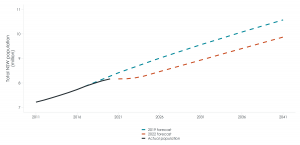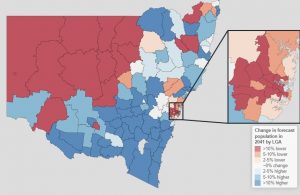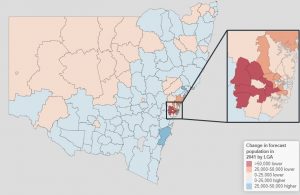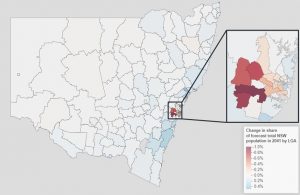The impact of COVID-19 on actual and forecast New South Wales population
Released in mid-2022, the 2022 NSW Population Projections are the first population forecasts to be publicly released by the NSW government since the start of the COVID-19 pandemic.[1]
An analysis of these forecasts, in comparison with the previous forecasts undertaken in 2019,[2] provides insight into the impact of the pandemic on:
- the current level of population;[3] and
- the long-term projected level of population to 2041.
Forecast NSW population is much lower today than in previous projections
Figure 1 shows that the most recent estimate of NSW population in 2021 is 2.9 per cent lower than the forecast made in 2019, a total of approximately 250,000 people.
Figure 1: Total forecast population in NSW

Some of this lower outturn population relative to the 2019 forecast occurred prior to the onset of the COVID-19 pandemic, as indicated by dotted blue line lying above the solid black line in 2017, 2018 and 2019.
Looking towards 2041 and this gap increases to 6.5 per cent between the two forecasts, with the 2022 forecast predicting almost 700,000 less residents in NSW by 2041 compared with the 2019 forecast.
Despite lower aggregate projected NSW population many rural and regional areas have higher expected population than previous projections
Looking at the data at the local government area (LGA) level provides some insight as to which areas of NSW have received the largest revisions in forecast population. Figure 2 shows the relative change in forecast population across all 129 LGAs in NSW, with an inset of the Sydney region, between the two forecasts in 2041.
Figure 2: Relative change in total forecast population in 2041 (2022 forecast relative to 2019 forecast)

This analysis shows that the NSW government’s forecast for the Sydney region is much lower in 2022 than in 2019. However, against the backdrop of lower aggregate population in the state there are many parts of rural and regional NSW, most notably in the South and South-West, for which the forecast population has significantly increased between the 2019 and 2022 forecasts.
Of the 129 LGAs across the state, 76 have experienced an increase in projected 2041 population in the 2022 forecast when compared with the 2019 forecast.
NSW wide forecast population changes are almost entirely contained in Western Sydney
The absolute change in population between these two forecasts, shown in figure 3, indicates that nearly all the 700,000 less persons forecast in NSW by 2041 are contained within the major population areas of Greater Western Sydney. These LGAs include:
- Blacktown – a decrease of 120,000 persons (20 per cent);
- Canterbury-Bankstown – a decrease of 68,000 persons (13 per cent);
- Camden – a decrease of 110,000 persons (36 per cent);
- Cumberland – a decrease of 63,000 persons (17 per cent);
- Liverpool – a decrease of 129,000 persons (29 per cent); and
- Penrith – a decrease of 99,000 persons (27 per cent).
Conversely, the forecast population of Maitland and Shoalhaven in 2041 have increased by 40,000 and 26,000 persons from pre-COVID projections, respectively.
Figure 3: Absolute change in total forecast population in 2041 (2022 forecast relative to 2019 forecast)

These results are not unexpected due to the heavy concentration of NSW population growth that is expected in the Western Sydney area. As a result, we would expect most of the change in forecast population to occur in these areas. Moreover, most LGAs outside of Sydney have relatively small populations so small changes to these forecasts in absolute terms may be represented as large relative changes.
The 2022 Population Projections attribute a smaller share of total NSW population to Western Sydney than previous projections
Bearing the above in mind, the change in the share of total forecast NSW population attributed to each LGA between the two forecasts is presented in figure 4. This shows that the share of total NSW population attributed to Western Sydney has decreased significantly in the 2022 forecast.
Figure 4: Change in share of total forecast NSW population in 2041 (2022 forecast relative to 2019 forecast)

The combined population of the Blacktown, Camden, Campbelltown, Canterbury-Bankstown, Cumberland, Fairfield, Liverpool, Parramatta and Penrith LGAs account for only 29.3 per cent of total NSW population in 2041 under the 2022 forecast. This represents a decrease of over 13 per cent relative to the proportion under the 2019 forecast, which was equal to 33.7 per cent. This decrease in total population share for Western Sydney is particularly prominent in:
- Blacktown – with forecast NSW population share decreasing from 5.8 per cent in the 2019 forecast to 5.0 per cent in the 2022 forecast;
- Camden – with forecast NSW population share decreasing from 2.9 per cent in the 2019 forecast to 2.0 per cent in the 2022 forecast;
- Liverpool – with forecast NSW population share decreasing from 4.2 per cent in the 2019 forecast to 3.1 per cent in the 2022 forecast; and
- Penrith – with forecast NSW population share decreasing from 3.5 per cent in the 2019 forecast to 2.7 per cent in the 2022 forecast.
To offset this decrease in total NSW population share to Western Sydney, the remainder of the state experiences a slight increase in the share of total NSW population. Unsurprisingly, areas in the South of NSW receive the largest increase in relative population share in state.
What have we learned?
There are three key points that we can take from this analysis, namely:
- The NSW government’s current projection of the size of the state in 2041 is around 6.5 per cent lower than pre-COVID forecasts, which increases steadily from the 2.9 per cent forecast change in 2021.
- Despite the declining aggregate state population, many regional and rural areas are now forecast to have larger future population than pre-COVID projections, possibly reflecting the rise of the ‘seachange’ and ‘treechange’ trends in a post COVID world.
- The NSW government has revised its expectation on the proportion of total state population residing in Western Sydney downwards from pre-COVID levels.
This last two points are relevant given the significant investment in public infrastructure underway to support high population growth in Western Sydney. With the NSW government’s view of a materially less populated Western Sydney and a more even spread of population across the state, it will be interesting to see if the focus and location of public spending follows suit.

[1] The 2022 NSW Population Projections are available at https://www.planning.nsw.gov.au/Research-and-Demography/Population-Projections.
[2] Both the 2019 and 2022 forecasts extend to 2041, with the 2019 forecasts at five year intervals and the 2022 forecast covering each year.
[3] The 2022 NSW Population Projections include historic population data up until 2020 derived from the Australian Bureau of Statistics, available at https://www.abs.gov.au/statistics/people/population/regional-population-age-and-sex/latest-release.